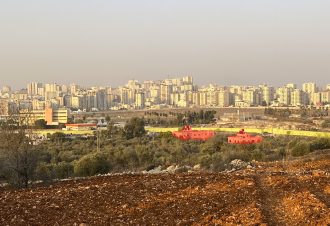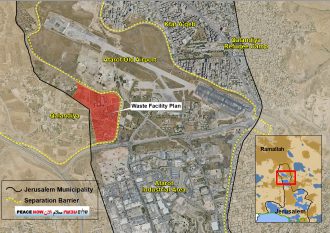About two weeks ago, officials from the Israel Land Authority arrived in the village of Qalandiya, north of Jerusalem and outside the separation barrier, and delivered eviction notices to residents of two apartment buildings. The orders require the families—dozens of Palestinians from several households—to vacate their homes and adjoining agricultural lands within 20 days. The residents say they plan to launch a legal challenge to prevent their removal.

The land designated for the waste facility and the two houses that received eviction orders. Behind the houses – the separation barrier.
In June 2024, the Israeli government tasked Eden, a municipal development company owned by the Jerusalem Municipality, with locating a site for a waste treatment and energy recovery facility for the city. The company proposed a 130-dunam (about 32-acre) tract in Qalandiya—land that, while technically within Jerusalem’s municipal boundaries, lies beyond the barrier. Much of the land is cultivated farmland and includes at least seven residential buildings housing dozens, possibly hundreds, of Palestinians.
In April 2025, Finance Minister Bezalel Smotrich signed a notice under Section 19 of the Land Ordinance, activating two old expropriations from 1970 and 1982 covering the same area. That notice now serves as the legal basis for the eviction orders delivered to residents.
A month later, the government formally decided to build the waste facility on the Qalandiya site proposed by Eden and to reroute the separation barrier so that the area would fall on the “Israeli” side. The cabinet also allocated millions of shekels for planning and construction, including roughly 12 million shekels (about $3 million) from the Environmental Protection Ministry’s Cleanliness Fund to finance the relocation of the barrier.
The decision effectively means the displacement of local residents from their homes and farmland to make way for the planned plant.
Peace Now: The government’s appetite for annexation and dispossession knows no bounds. As if there were no other place in the Jerusalem area to build a waste facility besides the few remaining dunams left to Qalandiya’s residents after decades of expropriations and fences. This would constitute a blatant violation of international law and basic moral principles to expel residents living under occupation for the sake of a plant serving the occupying power.
A History of Expropriations in East Jerusalem
Immediately after the 1967 war, Israel extended its law and jurisdiction to about 70,000 dunams (roughly 17,300 acres) in East Jerusalem, expanding the city’s boundaries to include the Old City and 28 surrounding Palestinian villages and neighborhoods. The annexation line bisected the village of Qalandiya: most homes remained under Israeli military control in the West Bank, while much of the farmland and a few houses were incorporated into Jerusalem.
In the years following 1967, the government carried out sweeping land expropriations—totaling tens of thousands of dunams—for the construction of new Israeli settlements in East Jerusalem. Roughly one-third of the annexed area, about 24,000 dunams, was taken from Palestinian owners for neighborhoods such as Gilo, Ramot, French Hill, and Ramat Eshkol. The state offered compensation, but most Palestinian owners refused both payment and recognition of the seizures.
Land expropriation under Israeli law involves two stages: A notice of intent signed by the finance minister under Sections 5 and 7 of the Land Ordinance; and a second notice under Section 19, which enacts the expropriation in practice.
In many East Jerusalem cases, the government issued the first-stage notices for vast tracts, but later executed only parts of them, leaving some parcels in Palestinian ownership. In recent years, Israeli authorities have revived those dormant expropriations—sometimes decades after their original purpose had already been fulfilled—as in the case of the Amana House in Sheikh Jarrah.
In Qalandiya’s case, two expropriations were issued for the area where the waste facility is planned: one from August 30, 1970, covering about 1,200 dunams for the Atarot industrial zone (390 of them belonging to Qalandiya residents, the rest to Beit Hanina), and another from June 1, 1982, for 137 dunams intended for a security installation.
Although most of that land was used for the industrial zone and the security facility, some remained in Palestinian hands. In April 2025—decades later—Finance Minister Smotrich signed the Section 19 order activating the old expropriations. At the time of the original seizures, waste-to-energy plants did not exist in Israel, meaning the current project effectively repurposes the land for an entirely new civilian and commercial use. Reviving the old orders is a bureaucratic shortcut to remove residents without issuing new expropriations.
Moving the Separation Barrier
The government’s plan includes rerouting the separation barrier so the waste facility will fall on the Israeli side. Built around 2011, the barrier already cut Qalandiya off from about 40% of its farmland. Thirteen houses ended up on the Israeli side, separated from the village. Following a High Court petition, the state was forced to open a special gate allowing those families to cross. The gate operated for about 18 months for several hours a day, before being sealed during a Gaza operation, allegedly for security reasons. Since then, residents have to drive 11 kilometers and pass through a checkpoint instead of walking 300 meters to reach their village.
The planned facility would cover roughly 130 dunams, but rerouting the barrier is expected to confiscate additional land. A letter from the commander of the Central Command attached to the government’s decision stated:
“A security perimeter must be maintained on both sides of the barrier… Existing structures near the current route must be removed, and no new construction permitted. Before changing the route, all buildings located between the current and proposed lines must be cleared to avoid enclosing Qalandiya residents on the Israeli side.”
In practice, this means not only further land loss but also demolition of all houses between the old and new barrier lines, along with new building restrictions in the surrounding area.
During the barrier’s original construction, Israel repeatedly told the High Court and the international community that its route was determined solely for security reasons. The current plan, however, moves the barrier for civilian and commercial purposes—without any claimed security rationale.
Expected Next Steps
1. Planning the facility.
Following the cabinet decision, Eden issued a tender to select architects for the detailed planning. The firm Alefbet Architects was chosen and is expected to consult with foreign experts. Once a plan is ready, it will go before Israel’s National Infrastructure Committee for approval. Before final authorization, the plan will be diposited for public objections—a process that may take one to two years or more.
Eden has also hired retired Colonel Danny Tirza, who oversaw the original construction of the separation barrier, and attorney Itay Ofir, formerly with the Defense Ministry’s legal office and recently appointed Military Advocate General, to assist with planning.
2. Relocating the barrier.
In parallel, the military can begin proceedings to seize land for the new barrier route. Landowners may appeal the seizure orders; if rejected, they can petition the Supreme Court. Such proceedings could take several years.
3. Expropriation of the land.
The eviction notices distributed two weeks ago mark the first step in the takeover process. The owners of the lands are expected to contest the orders in court. Some houses within the planned site were not included in the 1970 and 1982 expropriations, meaning the state cannot rely on those old orders to remove them. In those cases, new expropriation proceedings—or “security” justifications related to the barrier’s route—may be invoked.
The overall process of building the waste treatment facility is expected to take several years. However the further the plan advances, the harder it will be to halt. This discriminatory project must be stopped now—before displacement and construction will be inevitable.


